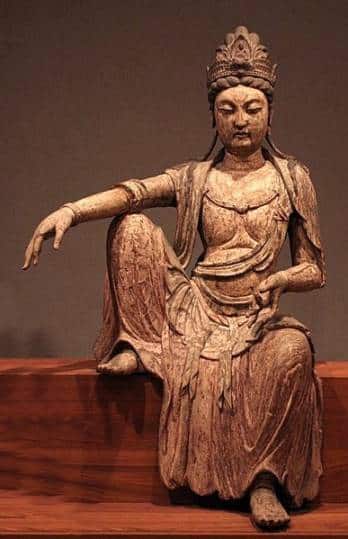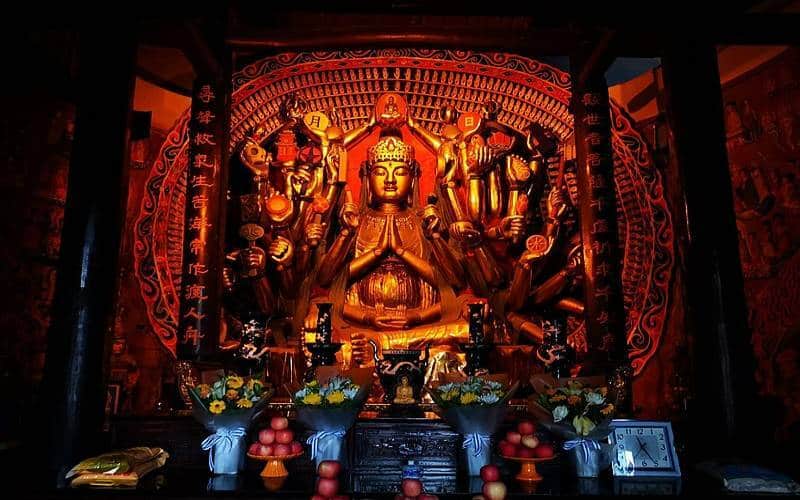”Woman’s work,” the Buddhas all agreed. “Who but a gentle mother could ever dream of bringing boundless love and comfort to all the people, easing the inevitable pains of human life?” After all, the man had failed and now lay shattered at their feet.
Carefully, they began reshaping the pieces of the Indian bodhisattva named Avalokitesvara, known as the Merciful Lord of Enlightenment.
God Becomes a Goddess
He once had chosen to remain on earth to relieve the suffering of humanity. Rather than to partake of the pleasures of Nirvana that he had earned. Now he was reborn as the goddess Kuan Yin. Ready to start his work again–this time in a female form that was better suited to the task.

And as part of this spectacular god-to-goddess makeover, the Buddhas equipped her with a thousand arms . All the better to reach out and stop the suffering of those around the world. Next they placed eyes in the palms of her hands so that she could see anyone in need.
Just as you’d expect from a goddess who figures in the mythology of so many different countries, there is a myriad of varying stories we could choose to retell about Kuan Yin. So we’ve selected a few of our favorites to share with you.
Kuan Yin: She Who Sees and Hears the Cries of the World
As an archetype, the goddess Kuan Yin has no equal. Centuries later, we find echoes of her myths in folk tales and literature, works as enduring as Cinderella, Snow White, and even Shakespeare’s King Lear. Her story is truly the story of all stories…
The Princess Who Became the Goddess Kuan Yin
Villagers knew at once that something phenomenal had just occurred. At the very moment the Queen had given birth, the earth had trembled beneath their feet as fragrant blossoms sprang up through the winter snow that covered the hillsides.
The King and Queen, however, were not impressed. They had asked for a boy, wanting a son who could consolidate their power and their wealth. What use was yet another daughter, especially one like Miao-Shan, who was so kind and pure?
Eventually, they decided to marry her off to a wealthy man. But Miao-Shan refused, telling them she would do so only on three conditions. She would comply only if the marriage would relieve the suffering endured in old age, ease the pain of those who are ill, and comfort the dying and those bereaved.
Miao-Shan as A Cinderella Archetype
She begged to be allowed to become a nun instead. But her father was enraged and forced her to do all the menial tasks around their home for her refusal. To make matters worse, her mother and two sisters taunted her unmercifully as she slaved away at her chores.
At night, while the others slept, Miao-Shan stoked the fires and swept the floors, and chopped up all the vegetables for the next day’s meals without complaint. The animals living around the palace felt sorry for the poor princess, who was so kind and began to help her with the chores so she could nap.
Her father enraged that she could get so much done and still seem so refreshed, eventually agreed to let her go to the temple to become a nun. But, still angered by her insistence on helping the unfortunate, he ordered the nuns to treat her so badly that she would become disheartened and return home chastened and willing to submit to his authority.
Life in Monastery and The Attempted Assassination
The nuns put the Maio-Shan in charge of the food supply, managing the garden, and collecting water from the distant stream. They thought this would be disheartening since it was the middle of winter. To the shock of all, crops appeared in the garden, and a stream sprang up just outside the kitchen door.
When her father got word of these miracles, he decided to put an end to her life and sent one of his henchmen to kill her. As Maio-Shan knelt to bow her head for the axe, she meekly met the henchman’s eye and said, “You must not worry about what you have to do; you have been forgiven.”
Shaken, the henchman thrust his weapon into a nearby stone, and the axe shattered into a thousand pieces. Then the clouds came down from the hillside and carried the young nun to safety on a nearby island. There she continued her religious study, prayer, and meditation while living on her own.
The King On a Deathbed
A few years later, the king fell ill. His doctors said he would soon die. As his condition worsened, a traveling monk arrived. Some versions of the myth say it was actually Kuan Yin in disguise.
The monk told the king he knew of a possible cure. A medicine made from the ground-up eyes and arms of one who was full of love and forgiveness. The king called his other two daughters to his side, asking them to provide this gift of life. They, of course, refused.
Then the monk told him that he knew of someone he was sure would gladly make the sacrifice. Upon hearing this the king sent his envoy to make the request. Miao-Shan pulled out her eyes and severed her arms, telling the envoy to hurry to take them to the king so that he might be quickly healed.
The monk prepared the medicine and gave it to the king, who was quickly cured. He tried to thank the monk, but the monk refused. Ha instead said “It is the one who made the sacrifice that you should thank.”
The King Wants To Thank His Savior
So the king and his wife made the journey to the island. There they realized how much their daughter had given up. Miao-Shan told them, “Knowing my father’s love, I was honored to be able to repay him with my arms and eyes.” And just at that moment, the clouds descended.
When the fog cleared, Miao-Shan was no longer there. The earth again began to tremble, and thousands of blossoms floated down from the sky. The royal family looked up and saw the goddess Kuan Yin in the sky, manifesting her thousand arms and eyes.
To honor their daughter, who was now known as the goddess Kuan Yin, they built a shrine on the place of her ascension and named it Fragrant Mountain.
Kuan Yin Symbols

Kuan Yin, as a goddess of compassion, forgiveness, and sacrifice, was often represented by symbols that were also associated with compassion, empathy, and forgiveness.
General
White flowing robes, a vase of dew/nectar, rice cakes, six arms (or a thousand), eight heads – one sitting atop the next, eyes on the palms of the hands, the number 33, a boat made of bark, the Hou (a mythological creature resembling the Buddhist lion), and a rosary or book in one hand.
Animals
Fish (carp) is one of the most common Kuan Yin symbols, as this fish symbolizes strength, perseverance, good luck, and wealth. Just like carp fish are able to swim against the current, Kuan Yin was able to stay strong and keep going on against not-so-good life circumstances.
Other animal symbols of Kuan Yin are oysters, lions, and peacocks.
Plants
White lotus blossoms symbolize innocence and purity, as well as grace, peace, and being awakened/enlightened. It makes no wonder that this flower is a perfect symbol of Kuan Yin.
Other plant symbols of Kuan Yin are willow branches and other blossoming flowers.
Perfumes/Scents
The orange scent also symbolizes innocence and purity, loyalty, faithfulness, and moral virtue in general. This makes it a great choice to symbolize Kuan Yin’s innocence. Alternatively, the garlic scent is believed to ward off evil, which makes it another great symbol of Kuan Yin.
Gems and Metals
Jade is one of the most revered gemstones in many Asian cultures, and it was highly appreciated in ancient China. It is considered one of Kuan Yin’s symbols, as it represents serenity, gentleness, harmony, strength, balance, and healing.
Pearl is another great choice to symbolize Kuan Yin’s innocence, compassion, and purity.
Goddess Jewelry
There are many reasons why you might want to keep a healing crystal or stone close to you. Getting closer to your goddess by wearing her color or crystal is a great one. That they also look great as jewelry only makes it so much better!
Here is a guide to crystal jewelry you hopefully will find helpful. In it is a list of 30+ crystals and links to some really great looking jewelry with that crystal or stone. Enjoy!
Colors
White is a color associated with innocence in many cultures of the world. Kuan Yin is often depicted as wearing white robes, and for a reason: her white robes represent her innocence and compassion.
Other Goddesses
If you enjoyed this post we are sure you will enjoy getting to know some of the other goddesses we also write about. You can find the complete list of goddesses sorted across regions and religions here.
Featured Image Credit: Nyarlathotep1001, CC BY-SA 4.0 , via Wikimedia Commons


